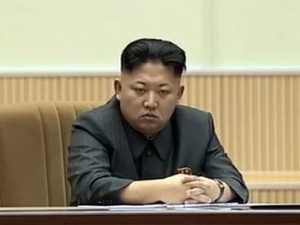North Korea leader warns of ‘very grave’ situation
SEOUL — North Korean leader Kim Jong-Un has warned of a “very grave” situation on the Korean peninsula, where a surge in military tensions has seen the two Koreas trade artillery fire and Pyongyang threaten a new nuclear test.
In a meeting with top military leaders on Tuesday, Kim blamed Washington and Seoul for the current frictions, saying they had trampled on peace overtures from Pyongyang.
“The current situation is very grave,” Kim was quoted as saying by the North’s official KCNA news agency on Wednesday.
Kim, the supreme commander of the Korean People’s Army (KPA), told his most senior officers that despite the North’s conciliatory gestures, South Korea and the United States had pushed ahead with joint military drills that Pyongyang views as rehearsals for an invasion.
“The United States and other hostile forces, ignoring our magnanimity and goodwill, are viciously stepping up their manoeuvres in order to annihilate our republic politically, isolate it economically and crush it militarily,” he said.
The North Korean military and people will never tolerate the “US policy of hostility” and will “crush it thoroughly”, Kim added.
The rhetoric seemed largely aimed at a domestic audience and Kim’s more combative remarks were not translated in the English version of the KCNA dispatch.
Just one month ago, inter-Korean relations appeared to be enjoying something of a thaw.
In February the two rivals held rare, high-level talks, after which they held the first reunion in more than three years for families divided by the 1950-53 Korean War.
Even when the annual South Korean-US military exercises began at the end of February, the protests from Pyongyang were relatively muted, and there was talk of further high-level meetings and greater cooperation.
But the mood soon soured, and recent weeks have seen North Korea conduct a series of rocket and missile tests, culminating last month in the test-firing of two medium-range ballistic missiles capable of striking Japan.
On Monday, North Korea conducted a live-fire drill along the disputed maritime border. After some shells crossed the boundary, South Korea responded and the two sides fired hundreds of artillery rounds into each other’s territorial waters.
The exchange of fire came the day after North Korea sounded an ominous warning that it might carry out a “new” type of nuclear test — a possible reference to testing a uranium-based device or a miniaturized warhead small enough to fit on a ballistic missile.
Although South Korean intelligence reports say there are no signs of an imminent test, analysts note that the North is treading a familiar path that has previously ended in an underground bunker.
“The most disturbing possibility is that recent steps might conform with a pattern: missile test, UN condemnation, nuclear threat, nuclear test,” said Stephan Haggard, professor at the School of International Relations and Pacific Studies at the University of California, San Diego.
The UN Security Council condemned the North’s mid-range missile launches — a violation of UN resolutions prohibiting North Korean ballistic missile tests — and said it would consider “appropriate” action.
That could include asking the council’s North Korean Sanctions Committee to consider expanding its list of designated individuals and entities.
“That step would provide an excuse — if one were needed — for a fourth nuclear test,” Haggard wrote in a regular blog post.
North Korea has conducted three nuclear tests — in 2006, 2009 and 2013.
Last year’s was by far the largest and prompted speculation that the North may already have switched to testing a uranium device rather than plutonium.
A basic uranium bomb is no more potent than a basic plutonium one, but the uranium path holds various advantages for the North, which has substantial deposits of uranium ore.
A uranium enrichment programme is easy to hide. It does not need a reactor like plutonium, and can be carried out using centrifuge cascades in relatively small buildings that give off no heat and are hard to detect.
North Korea revealed it was enriching uranium in 2010 when it allowed foreign experts to visit a centrifuge facility at its Yongbyon nuclear complex.
RELATED STORIES
North Korea fires short-range rockets for 2nd day
